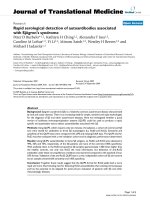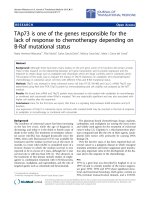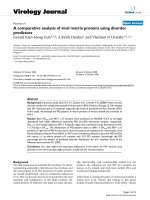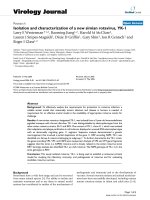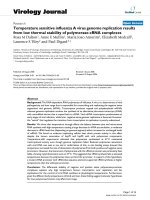Báo cáo hóa học: " Temperature Sensitive Nanocapsule of Complex Structural Form for Methane Storage" doc
Bạn đang xem bản rút gọn của tài liệu. Xem và tải ngay bản đầy đủ của tài liệu tại đây (650.86 KB, 6 trang )
NANO EXPRESS
Temperature Sensitive Nanocapsule of Complex Structural
Form for Methane Storage
E. I. Volkova
•
M. V. Suyetin
•
A. V. Vakhrushev
Received: 11 September 2009 / Accepted: 5 October 2009 / Published online: 16 October 2009
Ó to the authors 2009
Abstract The processes of methane adsorption, storage
and desorption by the nanocapsule are investigated with
molecular-dynamic modeling method. The specific nano-
capsule shape defines its functioning uniqueness: methane
is adsorbed under 40 MPa and at normal temperature with
further blocking of methane molecules the K@C60
1?
en-
dohedral complex in the nanocapsule by external electric
field, the storage is performed under normal external con-
ditions, and methane desorption is performed at 350 K.
The methane content in the nanocapsule during storage
reaches 11.09 mass%. The nanocapsule consists of tree
parts: storage chamber, junction and blocking chamber.
The storage chamber comprises the nanotube (20,20). The
blocking chamber is a short nanotube (20,20) with three
holes. The junction consists of the nanotube (10,10) and
nanotube (8,8); moreover, the nanotube (8,8) is connected
with the storage chamber and nanotube (10,10) with the
blocking chamber. The blocking chamber is opened and
closed by the transfer of the K@C
60
1?
endohedral complex
under electrostatic field action.
Keywords Methane storage Á Nanocapsule Á
Molecular dynamics
Introduction
The bucky shuttle [1, 2] being the combination of nanosize
carbon structures—fullerene [3] and nanotube [4], has
many possible applications: nanoscale storage cells [5],
devices for directed medicine transfer [6] and containers
for effective and safe gas storage [7–13]. Nanosize con-
tainers and capsules of various shapes that allow reaching a
higher safety level and mass content of gas stored have
been investigated for a number of years [11–13]. The
engineering of nanostructured carbon opens the ways for
the production of nanocapsules of complex structural
shapes [14–16].
In this work, the processes of methane molecule
adsorption, storage and desorption by the nanocapsule are
investigated with molecular-dynamic modeling method.
The nanocapsule-specific structure defines its adsorption
qualities: at the storage stage under normal conditions, the
nanocapsule contains the amount of methane that was
adsorbed at normal temperature and under 40 MPa.
Methane is stored in the nanocapsule under normal external
conditions. The nanocapsule desorption takes place at the
temperature elevation up to 350 K. There is no need to
apply electric field during storage and desorption.
Computational Model and Details
Methane adsorption, storage and desorption processes were
modeled with the method of molecular dynamics. The
calculations were made with the program NAMD [17]in
force field CHARMM27. The calculation results obtained
were visualized with the program VMD [18]. The values of
hydrogen and carbon atom charges in methane molecule
were obtained [11] using the combination of Hartree–Fock
E. I. Volkova
Izhevsk State Technical University, Studencheskaya str., 7,
426069 Izhevsk, Russia
M. V. Suyetin (&) Á A. V. Vakhrushev
Institute of Applied Mechanics Ub RAS, T.Baramzinoy str., 34,
426067 Izhevsk, Russia
e-mail:
123
Nanoscale Res Lett (2010) 5:205–210
DOI 10.1007/s11671-009-9466-8
and Becke exchange with Lee–Yang–Parr correlation
potential: B3LYP/6-31G(d) [19, 20]. The calculations were
made with the program Gaussian [21]. The following atom
charge values in methane molecule were obtained: carbon
atom -0.628204 Mulliken and hydrogen atom ?0.157051
Mulliken.
The object of investigation is the nanocapsule whose
structure is demonstrated in Fig. 1.
The nanocapsule consists of three parts: storage cham-
ber, junction and blocking chamber. The storage chamber
comprises the nanotube (20,20). The blocking chamber is a
short nanotube (20,20) with three holes. The junction
consists of the nanotube (10,10) and nanotube (8,8),
moreover, the nanotube (8,8) is connected with the storage
chamber, and nanotube (10,10) with the blocking chamber.
The blocking chamber is opened and closed by the transfer
of the K@C
60
1?
endohedral complex under electrostatic
field action. The charge of ?1|e| of the K@C
60
1?
endo-
hedral complex is uniformly distributed over the C
60
shell.
The nanotube (8,8) in the junction prevents the K@C60
1?
from entering the storage chamber. The nanotube (8,8)
diameter is rather large for the penetration of methane
molecules, but small for the transition of the K@C60
1?
.
Each hole in the blocking chamber is formed as a result of
removing 24 carbon atoms. Dangling bonds are saturated
by hydrogen atoms. The holes obtained are large enough
for free penetration of methane molecules into the nano-
tube internal space. The experiment on obtaining similar
holes with the application of electron beams is described in
[14]. It is shown that the beams can be focused on the area
1A
˚
in diameter. The holes in the nanotube can exist at the
temperatures up to 400 K; when the temperature elevates,
the hole diameter in the nanotubes considerably decreases
due to the motion and fusion of single vacancies [8–10].
During modeling, it is imitated that the nanocapsule is
placed on the substrate, i.e., the nanotube base is fixed—the
nanocapsule left end is demonstrated in Fig. 1. The change
in the nanotube diameter is also possible with the methods
of nanostructural engineering [14].
The charged endohedral complex K@C60
1?
moves in
the blocking chamber and junction under the action of
external electric field. The electric field direction defines
the nanocapsule state in the operation cycle: methane
adsorption, its storage and desorption. The value of exter-
nal electric field intensity, required for the K@C60
1?
to
move, equals 3.045 9 10
9
V/m. The motion of charged
fullerene in the nanotube with the help of electric field is
described in detail in [5].
Results and Discussion
The nanocapsule operation can be split into several stages:
methane adsorption, storage and desorption.
At the adsorption stage (Fig. 2), the K@C60
1?
endo-
hedral complex is retained at the end of the blocking
chamber under the action of Van der Waals forces. The
methane molecules from the environment freely penetrate
through the three holes into the blocking chamber and
adsorb into the external space of the storage chamber. The
external thermodynamic conditions are T = 300 K and
P = 40 MPa. The storage chamber space adsorbs 485
methane molecules , which is 11.09 mass%.
The calculations are based on the following formula (1):
mass ¼
N
CH
4
 m
CH
4
N
CH
4
 m
CH
4
þ N
C
 m
C
 100% ð1Þ
where N
CH
4
—number of methane molecules, N
C
—number
of carbon atoms in the nanotube, m
CH
4
—mass of one
methane molecule and m
C
—mass of one carbon atom.
The storage area
The junction
The locking chamber
Fig. 1 Nanocapsule for natural
gas storage, consisting of
storage chamber, junction and
blocking chamber
Fig. 2 Adsorption stage (T=300 K, P = 40 MPa)
206 Nanoscale Res Lett (2010) 5:205–210
123
Figure 3 demonstrates the nanocapsule filling dynamics
with methane at 300 K and under 40 MPa. It is clearly seen
that 4 ps is enough to complete the filling of the nano-
capsule storage area.
To block methane molecules in the storage chamber, it
is necessary to move the K@C60
1?
ion into the junction
with the help of electric field as shown in Fig. 4. External
thermodynamic conditions are T = 300 K and
P = 40 MPa. Further motion of the K@C60
1?
is blocked
by the junction narrow part—nanotube (8,8).
Figure 5 demonstrates the dependencies of the change in
the K@C60
1?
position and its kinetic energy under the
electric field action in the blocking chamber upon time. A
sharp increase in the K@C60
1?
kinetic energy equaled to
0.254 eV is observed at 0.5 ps, at the same time the velocity
reaches 327 m/s. This is explained by the electric field action
on the K@C60
1?
.Att = 1 ps, the K@C60
1?
kinetic energy
decreases significantly, reaching 0.000255 eV and further
up to 15 ps its value does not considerably increase. This is
explained by minor oscillations of the K@C60
1?
near the
right end of the blocking chamber. The K@C60
1?
is retained
due to Van der Waals forces. Under the constant action of
electric field, the K@C60
1?
kinetic energy increases again
and reaches 0.61 eV at t = 16.5 ps, i.e., the K@C60
1?
breaks off the blocking chamber and moves to the storage
chamber to block its entrance.
In the time period from t = 16.5 ps to t = 26.5 ps, the
considerable attenuating oscillations of the kinetic energy
conditioned by the K@C60
1?
motion along the blocking
chamber walls adjacent to the junction entrance are
observed. In this time period, each peak of the K@C60
1?
kinetic energy corresponds to the time moments after
passing the pentagonal rings in the structure of the blocking
chamber. Under the electric field action, the K@C60
1?
penetrates into the right end of the junction—nanotube
(10,10)—and blocks the outlet of methane molecules from
the storage chamber. During the penetration, a considerable
increase in the kinetic energy is observed, its maximum
value reaches 0.63 eV at t = 32 ps. After the K@C60
1?
passes the nanotube (10,10), the kinetic energy sharply
decreases conditioned by the K@C60
1?
deceleration in the
portion of the nanotube (8,8). In the interval from
t = 41.5 ps to t = 48.5 ps, the insignificant fluctuations of
the K@C60
1?
position connected with the compressed gas
pressure from one side and electric field action from
another are observed. The value of the K@C60
1?
kinetic
energy does not exceed 0.033 eV. In the process of
methane molecules adsorption, the maximum velocity of
the K@C60
1?
motion is 515.5 m/s (t = 32 ps).
When transferring to the storage stage, the electric field
switches off, and external thermodynamic conditions are
0
1
2
3
4
5
6
7
8
9
10
11
12
0 0,5 1 1,5 2 2,5 3 3,5 4 4,5 5 5,5 6
Time (ns)
Mass (%)
Fig. 3 Results of the molecular dynamics modeling of the nanocap-
sule methane adsorption. Thermodynamic conditions are P = 40
MPa and T = 300 K
Fig. 4 Nanocapsule closing stage (T = 300 K, P = 40 MPa)
0
5
10
15
20
25
30
35
40
45
0 5 10 15 20 25 30 35 40 45 50
Time (ps)
Position (A)
0
0,1
0,2
0,3
0,4
0,5
0,6
0,7
Energy (eV)
Position
Energy
Fig. 5 Results of molecular-dynamic modeling of the K@C
60
1?
motion in the blocking chamber under the electric field action at the
adsorption stage. The K@C
60
1?
ion position with respect to the initial
(time = 0 ps) ion position as a function of time. The change in the
K@C
60
1?
ion kinetic energy as a function of time
Nanoscale Res Lett (2010) 5:205–210 207
123
brought to normal. The K@C
60
1?
, which is located in the
junction, moves to the blocking chamber under the meth-
ane pressure. However, its transfer is insignificant
(Dd*5 A) that is conditioned by the necessity to overcome
the considerable energy barrier (DE = 90 kcal/mol) to
move to the blocking chamber. The nanocapsule state at
the storage stage is shown in Fig. 6. The nanocapsule with
methane molecules inside is in stable state. The calcula-
tions made show that there are no abnormal extensions of
bonds between carbon atoms in the nanocapsule.
At the desorption stage when the temperature elevates
from 300 K up to 350 K and the external pressure is nor-
mal, the K@C60
1?
endohedral complex in the junction is
pushed into the blocking chamber under the expanding
methane pressure, as shown in Fig. 7. Methane under
pressure in the storage chamber freely desorbs into the
external space through the holes in the blocking chamber.
The availability of three holes in the blocking chamber and
their configuration allow forcing out methane molecules
and preserving the required rigidity of the construction.
The holes are located in such a way that the K@C
60
1?
,
moving under the electric field action in the blocking
chamber, is unable to block all its holes at once. The
K@C60
1?
in the blocking chamber does not prevent
methane desorption as the gas molecules flowing out do not
touch it, and it is retained near the wall of the blocking
chamber adjacent to the junction inlet—nanotube (10,10)
due to the action of Van der Waals forces without the
external electric field involved.
Figure 8 demonstrates the dependencies of the
K@C60
1?
location stage and its kinetic energy upon time
at the temperature elevation from T = 300 K up to
T = 350 K at the stage of the K@C60
1?
desorption into
the blocking chamber. At 3 ps, the significant increase in
the K@C60
1?
kinetic energy equaled to 2.05 eV (the
K@C60
1?
velocity reaches 930 m/s) is observed. The
K@C60
1?
kinetic energy is consumed for overcoming the
considerable energy barrier (DE = 90 kcal/mol) formed
under the action of capillary forces. When the K@C60
1?
passes the energy barrier, the kinetic energy decreases
considerably to 0.41 eV (t = 5 ps). After passing the
junction at 7 ps the K@C60
1?
, kinetic energy increases
again and reaches 0.92 eV. When the K@C60
1?
gets into
the blocking chamber, the oscillations between its walls are
observed. Each zero value of the K@C60
1?
kinetic energy
in the interval from 7 to 23 ps corresponds to the
K@C60
1?
impact against the blocking chamber wall.
Then, the insignificant impacts of the K@C60
1?
against
the blocking chamber wall with further state stabilization
near one of the pentagonal rings of the blocking chamber
are observed (Fig. 7). The maximum kinetic energy is
2.05 eV, which is considerably smaller than the known
value (200 eV) required for carbon nanotube destruction
[22]. The maximum velocity of the K@C60
1?
motion is
930 m/s. The availability of even insignificant number of
methane molecules in the blocking chamber considerably
decreases the velocity of the K@C60
1?
motion, and,
respectively, the kinetic energy of the K@C60
1?
impact
against the blocking chamber wall.
The methane molecules desorption process is shown in
Fig. 9. The thermodynamic conditions of desorption are
very similar to the hyperbola function graph. The desorp-
tion stops at 25.4 ps, there are 53 methane molecules in the
storage chamber, which is 1.38 mass%.
Fig. 6 Methane storage stage (T = 300 K, P = 0.1 MPa)
Fig. 7 Methane desorption stage (T = 350 K, P = 0.1 MPa)
208 Nanoscale Res Lett (2010) 5:205–210
123
Conclusion
We demonstrated the functioning of the nanocapsule of
complex structural shape for methane storage using the
method of molecular dynamics. An obvious advantage of
the nanocapsule is its operation cycle: methane is adsorbed
under the elevated pressure (40 MPa) and at normal tem-
perature with further blocking of methane molecules by the
K@C60
1?
endohedral complex in the nanocapsule with the
external electric field, the storage is performed in normal
external conditions, and methane desorption is performed
at temperature elevation up to 350 K, at which methane
molecules push out the K@C60
1?
and are desorbed from
the nanocapsule.
Methane content in the nanocapsule at the storage stage
is *11.09 mass%. At the storage and desorption stages,
the electric field is not used, this significantly simplifies the
use of nanocapsules in automobile applications.
The synthesis of similar nanocapsules is currently the
task of experimenters. The multiple techniques of nano-
structural engineering developed are the prerequisites for
the creation of similar nanocapsules.
Acknowledgments Calculations are made in Interdepartmental
Supercomputer Center of the Russian Academy of Science (Moscow).
References
1. B.W. Smith, M. Monthioux, D.E. Luzzi, Encapsulated C60 in
carbon nanotubes. Nature 396, 323–324 (1998)
2. B.W. Smith, D.E. Luzzi, Formation mechanism of fullerene
peapods and coaxial tubes: a path to large scale synthesis. Chem.
Phys. Lett. 321, 169–174 (2000)
3. H.W. Kroto, J.R. Heath, S.C. O’Brien, R.F. Curl, R.E. Smalley,
C60: buckministerfullerene. Nature 318(6042), 162–163 (1985)
4. S. Iijima, Helical microtubules of graphitic carbon. Nature
354(6348), 56–58 (1991)
5. Y K. Kwon, D. Tomanek, S. Iijima, ‘‘Bucky Shuttle’’ memory
device: approach and molecular dynamic simulations. Phys. Rev.
Lett. 82, 1470–1473 (1999)
6. D. Baowan, N. Thamwattana, J. Hill, Encapsulation of C
60
ful-
lerenes into single-walled carbon nanotubes: Fundamental
mechanical principles and conventional applied mathematical
modeling. Phys. Rev. B. 76, 155411–155418 (2007)
7. Y.X. Ren, T.Y. Ng, K.M. Liew, State of hydrogen molecules
confined in C60 fullerene and carbon nanocapsule structures.
Carbon 44(3), 397–406 (2006)
8. X. Ye, X. Gu, X.G. Gong, T.K.M. Shing, Z.F. Liu, A nanocon-
tainer for the storage of hydrogen. Carbon 45(2), 315–320 (2007)
9. R.E. Barayas–Barrraza, R.A. Guirado–Lopez, Clustering of H
2
molecules encapsulated in fullerene structures. Phys. Rev. B
Condens. Matter. 66(15), 155426.1–155426.12 (2002)
10. T. Oku, M. Kuno, Synthesis, argon/hydrogen storage and mag-
netic properties of boron nitride nanotubes and nanocapsules.
Diamond Relat Mater 12(3–7), 840–845 (2003)
11. A.V. Vakhrushev, M.V. Suyetin, Methane storage in bottle-like
nanocapsules. Nanotechnology 20, 125602.1–125602.5 (2009)
12. M.V. Suyetin, A.V. Vakhrushev, Nanocapsule for safe and
effective methane storage. Nanoscale Res. Lett. (2009). doi:
10.1007/s11671-009-9391-x
13. M.V. Suyetin, A.V. Vakhrushev, Temperature sensitive nano-
capsules for methane storage. Micro Nano Lett. (2009).
(Accepted)
14. A.V. Krasheninnikov, F. Banhart, Engineering of nanostructured
carbon materials with electron or ion beams. Nat. mater. 9, 723–
733 (2007)
15. F. Banhart, J.X. Li, A.V. Krasheninnikov, Carbon nanotubes
under electron irradiation: stability of the tubes and their action as
pipe for atom transport. Phys. Rev. B. 71(24), 241408.1–
241408.4 (2008)
16. F. Banhart, Irradiation of carbon nanotubes with focused electron
beam in the electron microscope. J. Mater. Sci. 41, 4505–4511
(2006)
17. J.C. Phillips, R. Braun, W. Wang, J. Gumbart, E. Tajkhorshid, E.
Villa et al., Scalable molecular dynamics with NAMD. Comp.
Chem. 26, 1781–1802 (2005)
18. W. Humphrey, A. Dalke, K. Schulten, VMD—visual molecular
dynamics. J. Molec. Graphics 14.1, 33–38 (1996)
0
2
4
6
8
10
12
14
16
18
20
22
24
26
28
30
32
34
0 2 4 6 8 10 12 14 16 18 20 22 24 26 28 30 32 34 36 38 40
Time (ns)
Position (A)
0
0,2
0,4
0,6
0,8
1
1,2
1,4
1,6
1,8
2
2,2
Energy (eV)
Position
Energy
Fig. 8 Results of molecular-dynamic modeling of the K@C
60
1?
transfer at the temperature elevation up to 350 K. K@C
60
1?
ion
position with respect to the initial (time = 0 ps.) ion position as a
function of time. The change in the K@C
60
1?
ion kinetic energy as a
function of time
0
1
2
3
4
5
6
7
8
9
10
11
12
012345678910111213141516171819202122232425262728
Time (ns)
Mass (%)
Fig. 9 Results of the molecular dynamics simulation of methane
molecules desorption from the nanocapsule. Thermodynamic condi-
tions are P = 0.1 MPa and T = 350 K
Nanoscale Res Lett (2010) 5:205–210 209
123
19. A.D. Becke, A new mixing of Hartree–Fock and local
density functional theories. J. Chem. Phys. 98(2), 1372–1377
(1993)
20. A.D. Becke, Density—functional thermochemistry I. The effect
of the exchange—only gradient correction. J. Chem. Phys. 96(3),
2155–2160 (1992)
21. M.J. Frisch, G.W. Trucks, H.B. Schlegel, G.E. Scuseria, M.A.
Robb, J.R. Cheeseman, et al., Gaussian 98 (Revision A.1).
(US. Gaussian Inc, Pittsburgh, PA, 1998)
22. H G. Busmann, Th. Lill, I.V. Hertel, Near specular reflection of
C60 ions in collisions with an HOPG graphite surface. Chem.
Phys. Lett. 187(5), 459–465 (1991)
210 Nanoscale Res Lett (2010) 5:205–210
123
